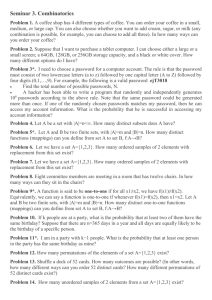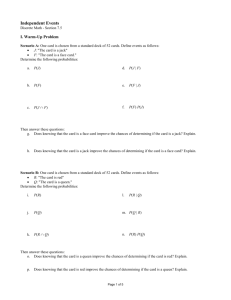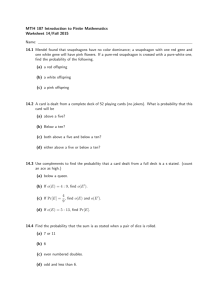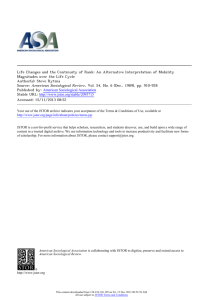1 Introduction Science As A Way of Knowing Science As A Way of
advertisement
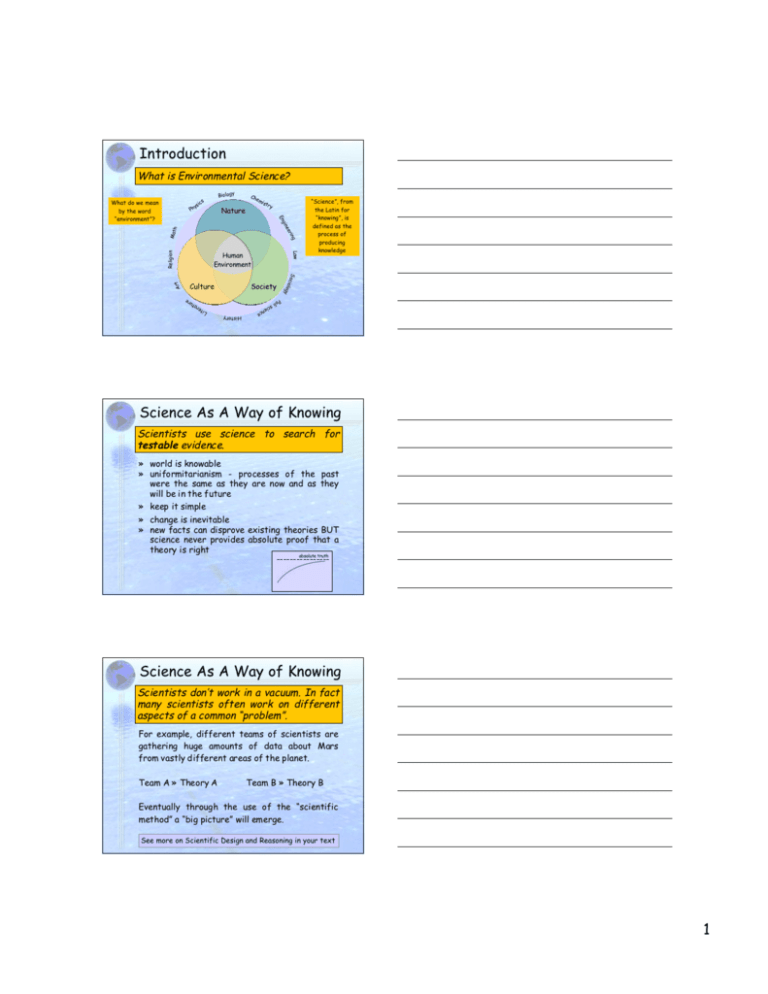
Introduction What is Environmental Science? Biology ics ys Ph Nature Ch em ist ry Mat h g rin ee gin En What do we mean by the word “environment”? e nc cie li s Po History Religion Art Society Soc iolo gy Culture Law Human Environment “Science”, from the Latin for “knowing”, is defined as the process of producing knowledge Lit er at ur e Science As A Way of Knowing Scientists use science to search for testable evidence. » world is knowable » uniformitarianism - processes of the past were the same as they are now and as they will be in the future » keep it simple » change is inevitable » new facts can disprove existing theories BUT science never provides absolute proof that a theory is right absolute truth Science As A Way of Knowing Scientists don’t work in a vacuum. In fact many scientists often work on different aspects of a common “problem”. For example, different teams of scientists are gathering huge amounts of data about Mars from vastly different areas of the planet. Team A » Theory A Team B » Theory B Eventually through the use of the “scientific method” a “big picture” will emerge. See more on Scientific Design and Reasoning in your text 1 Scientific Method Used by scientists to follow a series of logical, orderly steps to formulate and test hypotheses. make observations formulate an hypothesis statistics and probability are used with the scientific method test hypothesis consult prior knowledge collect data interpret data draw conclusions Statistics and Probability Statistics: “on average” frequency Average January Snowfall 30 35 40 45 50 55 60 inches of snow Statistics and Probability Statistics: “on average” frequency Average Annual Rainfall 30 35 40 45 50 55 60 inches of rain 2 Statistics and Probability Statistics: “on average” frequency Average Exam Grade 30 35 40 45 50 55 60 score Statistics and Probability Statistics: “on average” frequency Average Dose of Toxin Needed to Kill A Mouse 30 35 40 45 50 55 60 µg/kg Statistics and Probability Probability: “what are the chances?” Example in Book Every time you flip a coin, the chance that it will be tails is 1 tail out of 2 choices (heads or tails) = 1/2 = 50%, similarly the chance of getting 2 tails in a row would be 1/2 x 1/2 = 1/4 = 25% Chances of getting 5 tails in a row would be: 1/2 x 1/2 x 1/2 x 1/2 x 1/2 = 1/32 As you start the 5th flip, what are chances of getting tails? = 1/2 Out of 100 people, how many would be likely to flip 5 tails in a row? # students x odds for 1 = 100 x 1/32 ≈ 3 3 Statistics and Probability Probability: “what are the chances?” Example If you are dealt 2 cards from a standard deck of 52 cards, what are the odds of being dealt “pocket rockets” (i.e. 2 Aces)? First card dealt, chances of getting an ace are 4 Aces in deck out of 52 cards = 4/52 Second card dealt, chances of getting an ace are 3 Aces in deck out of 51 cards = 3/51 Therefore, chances of being dealt 2 Aces is 4/52 x 3/51 ≈ 0.004 = 4 in 1000 = 1 in 250 Science vs. “Junk” Science Baloney Detection Kit - Carl Sagan Table 1.2 in Text 1. 2. 3. 4. 5. 6. 7. How reliable are the sources of this claim? Is there reason to believe that they might have an agenda to pursue? Have the claims been verified by other sources? What data are presented in support of this opinion? What position does the majority of the scientific community hold in this issue? How does this claim fit with what we know about how the world works? Is it reasonable or contradictory? Are the arguments balanced and logical? Have proponents considered alternative points of view? What do you know about the sources of funding for a particular position? Are they financed by partisan groups? Where was evidence for competing theories published? Has it undergone impartial peer review? Thinking About Thinking Useful Ways of Thinking Figure 1.9 in Text Analytical Thinking Creative Thinking What parts make this problem? How could I do this differently? Critical Thinking What am I trying to do? Logical Thinking Can orderly reasoning help? Reflective Thinking What does it all mean? 4 History of Environmentalism Four Distinct Stages 1. Pragmatic resource conservation • Marsh, Roosevelt, Pinchot - utilitarian conservation “resources used for the greatest good, the greatest number and the longest time” 2. Nature preservation • Muir - biocentric preservation - “nature exists for its own sake regardless of its usefulness to us” 3. Concern about health and ecological damage • England - coal burning; Carson - Silent Spring - chemical toxins, etc 4. Global environmental citizenship • Earth Day (1970), U.N. Conference on the Huma n Environment (1972), Earth Summit (1992) State of the World Causes of Environmental Degradation 1. Human population growth - 1.4% per year 2. Food shortages / famines - soil erosion, nutrient depletion 3. Food security / distribution 4. Water deficits / contamination 5. Energy Production and Use - Fossil, Nuclear, Alternative 6. Global Climate Change / Ozone Depletion 7. Destruction of Habitat - tropical forests, coral reefs, wetlands 8. Toxic air and water pollutants 9. Solid and hazardous waste - NIMBY, NIMTOO 5

